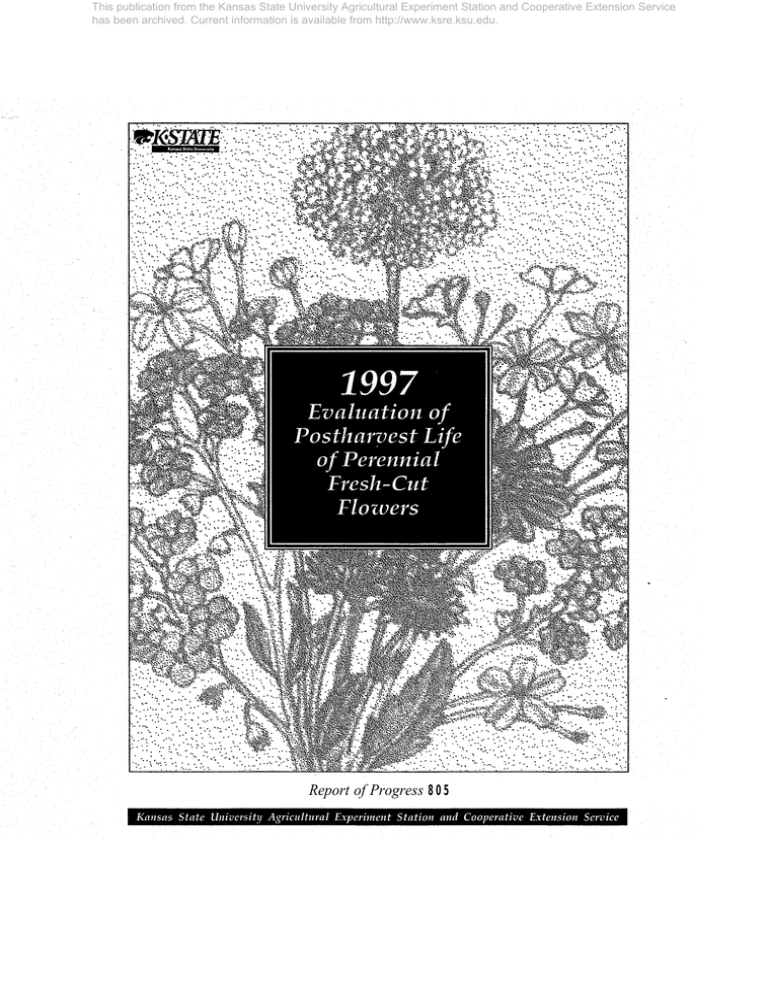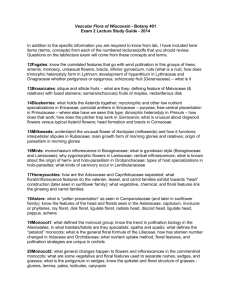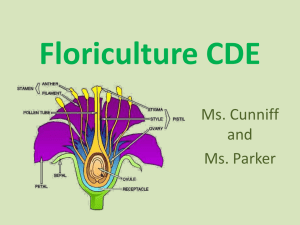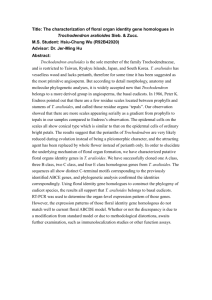
This publication from the Kansas State University Agricultural Experiment Station and Cooperative Extension Service
has been archived. Current information is available from http://www.ksre.ksu.edu.
Report of Progress 805
This publication from the Kansas State University Agricultural Experiment Station and Cooperative Extension Service
has been archived. Current information is available from http://www.ksre.ksu.edu.
1997 Evaluation of Postharvest Life of Perennial Fresh-Cut Flowers
Karen L.B. Gast, Ph.D.
Department of Horticulture, Forestry and Recreation Resources
Kansas State University
As consumers acquire a taste for more new and different flowers or specialty cut flowers,
growers and vendors need postharvest information to determine the expected vase life of these
flowers and the best way to extend it. Postharvest evaluations were conducted on autumn sedum,
blue spirea, hardy amaryllis, lobelia, oregano, and sunflowers. Included at the end of this report
is a section on other perennials that were planted in 1996 at the Kansas State University
Horticulture Research Center, Manhattan for determination of plant survival and postharvest
evaluations. These did not survive very well, so postharvest evaluations were not done.
Procedures
The objective of most postharvest evaluations was to determine whether silver thiosulfate (STS)
and floral preservatives improved the vase life of the flowers. A 2 by 2 factorial design was used.
The flower stems were either treated (pulsed) with STS for 30 minutes or not and then either held
in water or floral preservative, giving four treatments: 1) water with STS, 2) water without STS,
3) floral preservative with STS, and 4) floral preservative without STS. No STS was used with
hardy amaryllis or sunflowers; only water and floral preservative were compared. Pulsing is a
term used in the floral industry to describe fresh flower handling procedures where the fresh-cut
flowers are placed in a special solution for a giving period of time, usually 20 minutes to a couple
of hours.
Autumn Sedum
Autumn sedum is an herbaceous perennial that blooms in late August and September. The
umbels of pinkish purple flowers and succulent leaves make it an interesting new fresh-cut
flower.
The sepals of the individual flowers withered before the rest of the flowers, but this though did
not detract from the total appearance of the umbel of flowers. This is why the vase life of these
flowers is 3 to 4 weeks long (Table 1).
Flowers treated with STS lasted longer than those not treated. Without STS, no difference
occurred between water and floral preservative. Flowers in floral preservative with STS lasted
almost a week longer than those in water with STS.
1
This publication from the Kansas State University Agricultural Experiment Station and Cooperative Extension Service
has been archived. Current information is available from http://www.ksre.ksu.edu.
Table 1. Postharvest life of autumn sedum with or without silver thiosulfate (STS)
treatment and held in water or floral preservative.
Treatment
Postharvest Life (days)*
Floral preservative + STS
32.5 a
Water + STS
26.3 b
Floral preservative
23.9 c
Water
23.0 c
*Means followed by different letters are significantly different at the 5% level of probability.
Blue Spirea, Caryopteris x clandonensis ‘Blue Mist’
Blue spirea is a woody shrub that is marginally hardy in Kansas. It usually dies back to the
ground each winter, or it may be pruned back to 4-5 inches above the ground like an herbaceous
perennial. This procedure is recommended, because the new growth produced each year
promotes better flowering and desirable long stems. This cultivar has small blue flowers. The
undersides of the foliage are covered with white hair, which give it a silvery appearance. It can
be used as a filler flower for arrangements.
During postharvest evaluations, stems were checked daily to determine whether they were
showing signs of senescence, which included dropping of leaves and flowers, wilting of flowers,
and/or discoloration of leaves and flowers.
The STS-treated stems showed less shattering of leaves and flowers whether they were held in
water or floral preservative. Flowers held in water with or without STS lasted at least 2-3 days
longer than those in floral preservative with STS(Table 2). Flowers held in floral preservative
without STS lasted almost 2 days longer than those treated with STS. Thus, the STS treatment
appeared to be beneficial, but floral preservative did not.
Table 2. Postharvest life of blue spirea with or without silver thiosulfate (STS) treatment
and held in water or floral preservative.
Treatment
Postharvest Life (days)*
Water + STS
11.3 a
Water
10.1 a
Floral preservative
10.0 a
Floral preservative + STS
8.1 b
*Means followed by different letters are significantly different at the 5% level of probability.
Hardy Amaryllis
Hardy amaryllis is a true amaryllis and a hardy perennial bulb. It also is called surprise lily,
resurrection lily, and naked lady. The plant produces copious foliage in the spring, which dies
back. In July and August, it produces a leafless stem with 5-9 flowers on it, hence the name
surprise or naked lily.
2
This publication from the Kansas State University Agricultural Experiment Station and Cooperative Extension Service
has been archived. Current information is available from http://www.ksre.ksu.edu.
For postharvest evaluations, stems were placed in either water or floral preservative. The
number of flowers open, the number of flowers dead, and fresh weights were recorded daily.
The lower pH of the floral preservative solution caused the flower petals to turn bluish. Flower
stems in the water split and curled. No difference occurred between the treatments in the number
of days until all the flowers were dead or when the first flower died (Table 3). All the flowers
opened a day sooner in the water than in the floral preservative. The only other difference
between treatments was that the stems in floral preservative had a greater loss of fresh weight
overall than those in the water. The number of days that all the flowers were open, the last day all
flowers were open, and the day all flowers were dead did not differ between the treatments.
Table 3. Postharvest life of hardy amaryllis held in water or floral preservative z .
Treatment
Total
Postharvest
Life (days)
Day
All Flowers
Open
Number of
Days All
Flowers Open
Last Day
All Flowers
Open
Percent
Fresh Weight
Loss
Percent
Fresh
Gain
Weight
Floral
preservative 11.0NS
4.9*
2.1NS
6.0NS
36.0***
10.5NS
Water
10.9
3.8
2.9
5.7
16.9
18.7
z
NS
*, *** and mean means are different at the 5% and 0.1% level of probability and not significantly different.
Lobelia cardinalis, ‘Compliment Scarlet’
Lobelia cardinalis produces a spike inflorescence. Cultivars like ‘Compliment Scarlet’ have
been developed that produce a true red. Few red spike flowers are available in the trade, so this
will be a welcome addition.
During postharvest evaluations, number of flowers open, number of flowers dead, stem length,
and fresh weight were recorded daily.
More than double the number of flowers opened with the floral preservative treatments (Table 4).
The total postharvest life, the time when all flowers were dead, was longest with the floral
preservative. The vase life (defined as when half the flowers on the spike were dead) was
significantly longer with the floral preservative with STS treatment. The treatments had no effect
on the final stem length, but stems in the floral preservative treatments took 2-3 days longer to
reach their maximum length. Although no difference occurred in fresh weight gained, stems in
the floral preservative treatment took 4 ½ to 7 days longer to reach their maximum fresh weight.
The STS-treated stems took 2 ½ days longer to reach maximum fresh weight than those without
it. The fact that lobelia benefitted from the use of a floral preservative and STS is not surprising,
because it is a member of the bellflower family. Members of this plant family are sensitive to
ethylene. Their flowers wilt when exposed to endogenous and exogenous ethylene sources. STS
inhibits the toxic effect of ethylene on the flowers.
3
This publication from the Kansas State University Agricultural Experiment Station and Cooperative Extension Service
has been archived. Current information is available from http://www.ksre.ksu.edu.
Table 4. Postharvest life of Lobelia cardinalis, ‘Compliment Scarlet’ with or without silver
thiosulfate (STS) treatment and held in water or floral preservative.
Treatment
Floral preservative
+ STS
Water
+ STS
Floral preservative
Number of
Flowers
Opened
Total
Postharvest
Life (days)
Marketable
Postharvest
Life (days)
First Day at
Maximum
Stem Length
First Day at
Maximum
Fresh Weight
28.8 a
20.6 a
14.0 a
6.8 a
10.2 a
12.7 b
15.5 bc
9.8 bc
4.0 b
3.3 c
24.3 a
18.1 ab
10.7 b
5.9 a
7.7 b
Water
10.3 b
12.8 c
8.5 c
3.9 b
*Means followed by different letters are significantly different at the 5% level of probability.
3.3 c
Oregano
Oregano is most commonly known as a perennial culinary herb. Its aggressive growth habit
makes gardeners think carefully about where to plant it so it can be contained and what it can be
used for. It produces 18- to 24- inch flowering stems above the lower vegetative growth. These
are covered with clusters of small mauve to purple flowers. They make a good purple/lavender
filler for both fresh and dried bouquets.
During postharvest evaluations, fresh weights and vase life were evaluated and recorded daily.
Vase life ended when more than 50% of the flowers were dead.
The leaves on the stems in floral preservative developed brown necrotic spots. Stems in floral
preservative with STS lasted almost 1 ½ days longer than those without STS (Table 5). The STS
did not make a difference in vase life for the flowers held in water. Floral preservative alone
produced the shortest vase life, whereas the other treatments did not differ from each other.
Water alone gave an acceptable vase life. A continual increase in fresh weight is usually an
indication that the flower’s vascular system is active and the vase life will be prolonged. This
was not the case for oregano. Stems in floral preservative with STS took the longest time to reach
their greatest fresh weight but had the shortest vase life.
Table 5. Postharvest life and day at greatest fresh weight of oregano with or without silver
thiosulfate (STS) treatment and held in water or floral preservative.
Treatment
Postharvest
Day at
Life (days)*
Maximum
Fresh Weight
Floral preservative + STS
8.5 a
3.4 a
Floral preservative
7.0 b
2.5 b
Water + STS
8.1 a
1.8 b
Water
8.1 b
1.8 b
*Means followed by different letters are significantly different at the 5% level of probability.
4
This publication from the Kansas State University Agricultural Experiment Station and Cooperative Extension Service
has been archived. Current information is available from http://www.ksre.ksu.edu.
Sunflowers
Seven sunflower cultivars were evaluated, ‘Sunbright’, ‘Moonbeam’, ‘Velvet Queen’,
‘Sunbeam’, ‘Pastiche’, ‘Sunrich Orange F1', and ‘Prado Yellow’. Postharvest evaluations were
conducted by holding the stems in water. Flowers were judged to be dead when the ray florets
were wilted. A study comparing water vs. floral preservative was conducted with ‘Pastiche’,
‘Prado Yellow’, and ‘Sunbright’.
Sunbright outperformed the other six cultivars with a vase life in water that was 3 ½ days longer
(Table 6). The other six cultivars had similar vase lives of 6 to 7 ½ days. This gives the grower
a choice of good cultivars.
In the comparison study of water vs. floral preservative as a holding solution, the results were
mixed (Table 7). No difference occurred between the water and floral preservative for
‘Pastiche’. However, ‘Prado Yellow’ flowers lasted more than 3 days longer in the floral
preservative, whereas ‘Sunbright’ flowers lasted almost 2 days longer in water.
Table 6. Postharvest life of sunflower cultivars held in water.
Cultivars
Postharvest Life (days)*
Sunbright
11.1 a
Moonbeam
7.5 b
Velvet Queen
7.4 b
Sunbeam
7.1 b
Pastiche
6.7 b
Sunrich Orange F1
6.6 b
Prado Yellow.
6.1 b
*Means followed by different letters are significantly different at the 5% level of probability.
Table 7. Comparison of postharvest life of sunflower cultivars held in water and floral
preservative.
Cultivars
Postharvest Life (days)z
Sunbright
water
11.1*
floral preservative
7.9
Pastiche
water
6.6NS
floral preservative
9.1
Prado Yellow
water
6.0***
floral preservative
9.3
z
NS
*, *** and mean means are different at the 5% and 0.1% level of probability and not
significantly different.
5
This publication from the Kansas State University Agricultural Experiment Station and Cooperative Extension Service
has been archived. Current information is available from http://www.ksre.ksu.edu.
Other Perennials
In 1996, several species of herbaceous perennials were planted at the Kansas State University
Horticulture Research Center at Manhattan for postharvest evaluations and determination of
plant survivability. They included Veronica, Verbascum, Monarda, Asclepias, and Gaura.
Plants were set in well tilled beds and watered as needed for establishment. They were fertilized
with a 13-13-13 fertilizer. They were not mulched for winter protection. The decision was
made to see how hardy the plants were without protection.
Veronica ‘Blue Bouquet’. More than 140 plants were transplanted in the autumn of 1996. Less
than 20 plants survived the winter, and none produced flowers of marketable quality for
postharvest evaluations. Spring planting and winter protection may help this species produce a
marketable flower, but with the current cultivation, this cultivar and species does not appear to be
a good field cut flower.
Verbascum ‘Southern Comfort’. About 50 plants were transplanted in the spring of 1996. They
produced flowers that summer, but only 27 plants survived the winter. Flower production was
sparse and inconsistent in the plants. Individual flowers on the inflorescence opened and died
over a period of time, such that they would not be suitable for the retail and wholesale market
trade as a cut flower.
Monarda ‘Lambada’. Very few plants survived the winter. The ones that did survive produced
attractive lavender inflorescences. They lasted in floral preservative for almost 9 days.
Asclepias ‘Silky Gold’ and ‘Soulmate’. These did not overwinter very well. Only 2 out of 51
plants of ‘Silky Gold’ survived. The flowers lasted about 5 days in water. No ‘Soulmate’ plants
survived to flower.
Gaura ‘The Bride’. This is a woody shrub that dies back to the ground in winter in Kansas. The
current season’s growth has attractive reddish stems, lance shaped leaves, and white flowers, ½
to ¾ inch wide. One hundred twenty plants were planted in the spring of 1996. Only 37 survived
but spread to fill in the beds somewhat. The flowers shatter easily, but the leaved stems are
attractive as a foliage filler.
Acknowledgments
Thanks and appreciation go to the following people for their assistance in plant care and
maintenance, in data collection, and in manuscript preparation: Jennifer Neujahr; Livia Olsen;
Melinda McMillan; Jerry Longren and the crew at the Horticulture Research Center-Manhattan.
Contribution No. 98-310-S from the Kansas Agricultural Experiment Station. Trade names are
used to identify products. No endorsement is intended, nor is any criticism implied of similar
products not mentioned. These materials may be freely reproduced for educational purposes.
All other rights reserved. In each, case, give credit to the author(s), name of work, Kansas State
University, and the date the work was published.
6
This publication from the Kansas State University Agricultural Experiment Station and Cooperative Extension Service
has been archived. Current information is available from http://www.ksre.ksu.edu.
Kansas State University Agricultural Experiment Station and Cooperative Extension Service, Manhattan 66506
cim fam
March 1998
It is the policy of Kansas State University Agricultural Experiment Station and Cooperative Extension Service that all persons shall have equal opportunity and
access to its educational programs, services, activities, and materials without regard to race, color, religion, national origin, sex, age, or disability. Kansas State
500
University is an equal opportunity organization. These materials may be available in alternative formats.







